Papers by Naeemah Abrahams
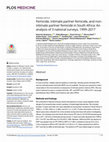
PLOS Medicine, Jan 17, 2024
Background AU : Pleaseconfirmthatallheadinglevelsarerepresentedcorrectly: In most countries, reli... more Background AU : Pleaseconfirmthatallheadinglevelsarerepresentedcorrectly: In most countries, reliable national statistics on femicide, intimate partner femicide (IPF), and non-intimate partner femicide (NIPF) are not available. Surveys are required to collect robust data on this most extreme consequence of intimate partner violence (IPV). We analysed 3 national surveys to compare femicide, IPF, and NIPF from 1999 to 2017 using agestandardised rates (ASRs) and incidence rate ratios (IRRs). Methods and findings We conducted 3 national mortuary-based retrospective surveys using weighted cluster designs from proportionate random samples of medicolegal laboratories. We included females 14 years and older who were identified as having been murdered in South Africa in 1999 (n = 3,793), 2009 (n = 2,363), and 2017 (n = 2,407). Further information on the murdered cases were collected from crime dockets during interviews with police investigating officers. Our findings show that South Africa had an IPF rate of 4.9/100AU : PleasenotethatasperPLOSs ,000 female population in 2017. All forms of femicide among women 14 years and older declined from 1999 to 2017. For IPF, the ASR was 9.5/100,000 in 1999. Between 1999 and 2009, the decline for NIPF was greater than for IPF (IRR for NIPF 0.47 (95% confidence interval (CI) 0.42 to 0.53) compared to IRR for IPF 0.69 (95% CI 0.63 to 0.77). Rates declined from 2009 to 2017 and did not differ by femicide type. The decline in IPF was initially larger for women
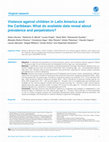
Revista panamericana de salud pública (Impresa), Oct 15, 2019
Objective. To describe the prevalence of recent physical, sexual, and emotional violence against ... more Objective. To describe the prevalence of recent physical, sexual, and emotional violence against children 0-19 years of age in Latin America and the Caribbean (LAC) by age, sex, and perpetrator. Methods. A systematic review and analysis of published literature and large international datasets was conducted. Eligible sources from first record to December 2015 contained age-, sex-, and perpetrator-specific data from LAC. Random effects meta-regressions were performed, adjusting for relevant quality covariates and differences in violence definitions. Results. Seventy-two surveys (2 publications and 70 datasets) met inclusion criteria, representing 1 449 estimates from 34 countries. Prevalence of physical and emotional violence by caregivers ranged from 30%-60%, and decreased with increasing age. Prevalence of physical violence by students (17%-61%) declined with age, while emotional violence remained constant (60%-92%). Prevalence of physical intimate partner violence (IPV) ranged from 13%-18% for girls aged 15-19 years. Few or no eligible past-year estimates were available for any violence against children less than 9 years and boys 16-19 years of age; sexual violence against boys (any age) and girls (under 15 years); IPV except for girls aged 15-19 years; and violence by authority figures (e.g., teachers) or via gangs/organized crime. Conclusion. Past-year physical and emotional violence by caregivers and students is widespread in LAC across all ages in childhood, as is IPV against girls aged 15-19 years. Data collection must be expanded in LAC to monitor progress towards the sustainable development goals, develop effective prevention and response strategies, and shed light on violence relating to organized crime/gangs.
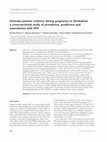
Tropical Medicine & International Health, Feb 17, 2013
objective To describe the occurrence, dynamics and predictors of intimate partner violence (IPV) ... more objective To describe the occurrence, dynamics and predictors of intimate partner violence (IPV) during pregnancy, including links with HIV, in urban Zimbabwe. methods A cross-sectional survey of 2042 post-natal women aged 15-49 years was conducted in six public primary healthcare clinics in low-income urban Zimbabwe. An adapted WHO questionnaire was used to measure IPV. Multivariate logistic regression was used to assess factors associated with IPV and severe (six or more episodes) IPV during pregnancy. results 63.1% of respondents reported physical, emotional and/or sexual IPV during pregnancy: 46.2% reported physical and/or sexual violence, 38.9% sexual violence, 15.9% physical violence and 10% reported severe violence during pregnancy. Physical violence was less common during pregnancy than during the last 12 months before pregnancy (15.9% [95% CI 14.3-17.5] vs. 21.3% [95% confidence interval 19.5-23.1]). Reported rates of emotional (40.3% [95% CI 38.1-42.3] vs. 44.0% [95% CI 41.8-46.1]) and sexual violence (35.6% [95% CI 33.5-37.7] vs. 38.9% [95% CI 36.8-41.0]) were high during and before pregnancy. Associated factors were having a younger male partner, gender inequities, past abuse, problem drinking, partner control of woman's reproductive health and risky sexual practices. HIV status was not associated with either IPV or severe IPV, but reporting a partner with a known HIV status was associated with a lower likelihood of severe abuse. conclusion The rates of IPV during pregnancy in Zimbabwe are among the highest ever reported globally. Primary prevention of violence during childhood through adolescence is urgently needed. Antenatal care may provide an opportunity for secondary prevention but this requires further work. The relationship between IPV and HIV is complex in contexts where both are endemic.
Bibliography: leaves 188-210.Violence against women is a universal problem and is widely recognis... more Bibliography: leaves 188-210.Violence against women is a universal problem and is widely recognised as a fundamental barrier to women's health and gender equality. Working with men to change their behaviour is increasingly acknowledged as a critical part of the solution to the problem. Data on risk factors that explain men's use of violence have been limited. Such data is required before interventions can be developed. The aims of this study was to describe the prevalence of different types of violence men use against their partners, as well as the risk factors for men's use of such violence. The study was based among men working at three municipalities in Cape Town. A random sample of 1800 names was chosen, from among which 1414 interviews were held. Prevalence estimates and risk factor analyses for use of violence against an intimate partner were done
Injury Prevention, Oct 1, 2012
Background There is a lack of national data on child homicides in South Africa and child abuse is... more Background There is a lack of national data on child homicides in South Africa and child abuse is considered to be a major problem.
Faculty of Health; Institute of Health and Biomedical Innovation, 2007
World Academy of Science, Engineering and Technology, International Journal of Humanities and Social Sciences, May 4, 2017
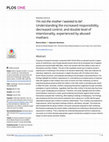
PLOS ONE, Jun 29, 2023
A paucity of research has been conducted within South Africa on abused women's experiences of mot... more A paucity of research has been conducted within South Africa on abused women's experiences of motherhood, even though abused women tend to be at increased risk of negative physical and mental health difficulties, which can interfere with their ability to take care of themselves and their children. The aim of this qualitative study was to explore women's experiences of mothering in the context of an abusive relationship. Data was collected via individual, telephonic, semi-structured, in-depth interviews with 16 mothers from three South African provinces, and analyzed according to the principles of grounded theory. Our findings highlight the mothers' experiences of: a simultaneous increased sense of responsibility with regards to their children and a loss of control over their mothering; as well as experiencing abuse aimed at either the mother or the child, which is simultaneously meant to affect the other; and lastly, mothers' assessing themselves negatively through normative paradigms of 'good mothering', regardless that they often mother in the best way they know how to, given challenging circumstances. Therefore, this study highlights that the motherhood institution continues to create 'good mothering' benchmarks against which women themselves evaluate their mothering, often leading to feelings of inadequacy. Our findings also emphasize that the environment created by men's abuse is in conflict with the great expectations placed upon mothers in abusive relationships. Thus, mothers may experience huge pressure, which may lead to feelings of failure, self-blame, and guilt. This study has demonstrated that the abuse mothers' encounter adversely impacted on their mothering. We therefore emphasize the need to better understand how mothering is influenced by and responsive to violence. This is important as understanding abused women's experiences can assist us to further develop appropriate support mechanisms needed to ensure minimal impact on both women and their children.
Journal of Black Studies, Mar 1, 2005
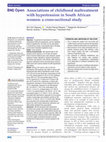
BMJ Open, Sep 1, 2022
Objectives To examine the associations of childhood maltreatment (CM) with hypertension, and the ... more Objectives To examine the associations of childhood maltreatment (CM) with hypertension, and the mediating effects of hypertension risk factors on the associations in South African women, using baseline data of the Rape Impact Cohort Evaluation longitudinal study. Design Cross-sectional Setting and participants Self-reported data on CM exposure and its severity in 18-40-year-old women living in KwaZulu-Natal province were assessed. Logistic regression models, adjusted for traditional hypertension risk factors, rape exposure, HIV-infection, other traumatic exposures, depression scores and acute stress reactions (ASR) scores were used to examine the CM-hypertension associations. Results Among 1797 women, 220 (12.2%) had hypertension; CM prevalence was higher in women with hypertension than without hypertension overall (70.9% vs 57.2%) and for each abuse type: sexual abuse (20.9% vs 12.4%), physical abuse (51.8% vs 41.5%), emotional abuse (40% vs 27.6%) and parental neglect (35% vs 25.7%). Exposures to 1-2 types and 3-4 types of CM were 46.4% and 24.5%, respectively, in women with hypertension, and lower in women without (42.9% and 14.3%, respectively). Exposures to any CM (adjusted OR: 1.62; 95% CI: 1.19 to 2.25), sexual abuse (1.64; 95% CI: 1.12 to 2.37), emotional abuse (1.57; 95% CI: 1.16 to 2.13), physical abuse (1.43; 95% CI: 1.07 to 1.92) and parental neglect (1.37; 95% CI: 1.00 to 1.86) were associated with hypertension. Exposures to an increasing number of abuse types and cumulative severity of CM overall (1.13; 95% CI: 1.05 to 1.21) and for each CM type were associated with increased odds of hypertension. Alcohol use, other trauma experienced, depression and ASR partially mediated these associations. Conclusion CM was associated with hypertension; the effects were greater with multiple abuse types and severe abuse, and were partially mediated by alcohol use, depression, ASR and other traumatic exposures. While CM must be prevented, effective mental health interventions to curb the uptake of unhealthy behaviours and the development of hypertension in women exposed to CM are key.
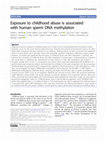
Journal of Hypertension, Apr 1, 2021
Offspring of persons exposed to childhood abuse are at higher risk of neurodevelopmental and phys... more Offspring of persons exposed to childhood abuse are at higher risk of neurodevelopmental and physical health disparities across the life course. Animal experiments have indicated that paternal environmental stressors can affect sperm DNA methylation and gene expression in an offspring. Childhood abuse has been associated with epigenetic marks in human blood, saliva, and brain tissue, with statistically significant methylation differences ranging widely. However, no studies have examined the association of childhood abuse with DNA methylation in gametes. We examined the association of childhood abuse with DNA methylation in human sperm. Combined physical, emotional, and sexual abuse in childhood was characterized as none, medium, or high. DNA methylation was assayed in 46 sperm samples from 34 men in a longitudinal non-clinical cohort using HumanMethylation450 BeadChips. We performed principal component analysis and examined the correlation of principal components with abuse exposure. Childhood abuse was associated with a component that captured 6.2% of total variance in DNA methylation (p < 0.05). Next, we investigated the regions differentially methylated by abuse exposure. We identified 12 DNA regions differentially methylated by childhood abuse, containing 64 probes and including sites on genes associated with neuronal function (MAPT, CLU), fat cell regulation (PRDM16), and immune function (SDK1). We examined adulthood health behaviors, mental health, and trauma exposure as potential mediators of an association between abuse and DNAm, and found that mental health and trauma exposure partly mediated the association. Finally, we constructed a parsimonious epigenetic marker for childhood abuse using a machine learning approach, which identified three probes that predicted high vs. no childhood abuse in 71% of participants. Our results suggested that childhood abuse is associated with sperm DNA methylation, which may have implications for offspring development. Larger samples are needed to identify with greater confidence specific genomic regions differentially methylated by childhood abuse.
This chapter provides further context for understanding filicide through a focus on South Africa.... more This chapter provides further context for understanding filicide through a focus on South Africa. The chapter draws on data collected for the national child homicide study and the pilot child death review project to explore this phenomenon in a developing country context. Through a combination of these data sources, the authors find that filicide is committed in the context of high levels of violence, intimate partner violence and violence against children, which is somewhat different to what is commonly experienced in developed settings. The chapter shows that family breakdown is at the centre of this phenomenon is this context, with psychological explanations not sufficient to capture the complexity.

Substance Abuse Treatment Prevention and Policy, Jun 22, 2023
Background The association of traumatic experiences with problematic alcohol use has been describ... more Background The association of traumatic experiences with problematic alcohol use has been described, but data on possible mediation effects of mental distress are sparse. We examined whether mental ill-health mediated the association between trauma exposure across the lifespan and alcohol use. Method We analysed cross-sectional data from a sample of rape-exposed and non-rape-exposed women, living in KwaZulu-Natal, with self-reported data on alcohol misuse (AUDIT-C cutoff ≥ 3) and exposure to childhood maltreatment (CM), intimate partner violence (IPV), non-partner sexual violence (NPSV), other traumatic events, and mental ill-health. Logistic regression and multiple mediation models were used to test the mediation effects of symptoms of depression and PTSS on the association between abuse/trauma and alcohol misuse. Results Of 1615 women, 31% (n = 498) reported alcohol misuse. Exposure to any CM (adjusted odds ratio (aOR): 1.59, 95% confidence interval (CI): 1.27-1.99), as well as to sexual, physical and emotional CM, were independently associated with alcohol misuse. Lifetime exposure to any IPV (aOR:2.01, 95%CI:1.59-2.54), as well as to physical, emotional and economic IPV, NPSV (aOR: 1.75, 95%CI: 1.32-2.33), and other trauma (aOR:2.08, 95%CI:1.62-2.66), was associated with alcohol misuse. Exposure to an increasing number of abuse types, and other traumatic events, was independently associated with alcohol misuse. PTSS partially mediated the associations of CM, IPV, NPSV and other trauma exposures with alcohol misuse (ps ≤ 0.04 for indirect effects), but depression symptoms did not. Conclusions These findings highlight the need for trauma-informed interventions to address alcohol misuse that are tailored to the needs of women who have experienced violence.
Journal of Hypertension, Jun 1, 2022
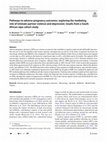
Archives of women's mental health, Apr 10, 2023
Adverse pregnancy outcomes (APOs) are common occurrences that contribute to negative maternal and... more Adverse pregnancy outcomes (APOs) are common occurrences that contribute to negative maternal and child health outcomes. Our aim was to test the hypothesis that trauma exposure and depression are drivers of the better-recognised risk factors for miscarriage, abortion and stillbirths. Our comparative cohort study based in Durban, South Africa recruited women who reported a recent rape (n = 852) and those who had never experienced rape (n = 853), with follow-up for 36 months. We explored APOs (miscarriage, abortion or stillbirth) among those having a pregnancy during follow-up (n = 453). Potential mediators were baseline depression, post-traumatic stress symptoms, substance abuse, HbA1C, BMI, hypertension and smoking. A structural equation model (SEM) was used to determine direct and indirect paths to APO. Overall, 26.6% of the women had a pregnancy in the follow-up period and 29.4% ended in an APO, with miscarriage (19.9%) the most common outcome, followed by abortion (6.6%) and stillbirths (2.9%). The SEM showed two direct pathways from exposure to childhood trauma, rape and other trauma, to APO which were ultimately mediated by hypertension and/or BMI, but all paths to BMI were mediated by depression and IPV-mediated pathways from childhood and other trauma to hypertension. Food insecurity mediated a pathway from experiences of trauma in childhood to depression. Our study confirms the important role of trauma exposure, including rape, and depression on APOs, through their impact on hypertension and BMI. It is critical that violence against women and mental health are more systematically addressed in antenatal, pregnancy and postnatal care.

AIDS, Dec 1, 2020
Objective: To determine the incidence of HIV acquisition in women postrape compared with a cohort... more Objective: To determine the incidence of HIV acquisition in women postrape compared with a cohort of women who had not been raped. Design: A prospective cohort study. Methods: The Rape Impact Cohort Evaluation study based in Durban, South Africa, enrolled women aged 16–40 years from postrape care services, and a control group of women from Primary Healthcare services. Women who were HIV negative at baseline (441 in the rape-exposed group and 578 in the control group) were followed for 12–36 months with assessments every 3 months in the first year and every 6 months thereafter. Multivariable Cox regression models adjusted for baseline and time varying covariates were used to investigate the effect of rape exposure on HIV incidence over follow-up. Results: Eighty-six women acquired HIV during 1605.5 total person-years of follow-up, with an incident rate of 6.6 per 100 person-years [95% confidence interval (CI): 4.8–9.1] among the rape exposed group and 4.7 per 100 person-years (95% CI: 3.5–6.2) among control group. After controlling for confounders (age, previous trauma, social support, perceived stress, multiple partners and transactional sex with a casual partner), women exposed to rape had a 60% increased risk of acquiring HIV [adjusted hazard ratio: 1.59 (95% CI: 1.01–2.48)] compared with those not exposed. Survival analysis showed difference in HIV incident occurred after month 9. Conclusion: Rape is a long-term risk factor for HIV acquisition. Rape survivors need both immediate and long-term HIV prevention and care.











Uploads
Papers by Naeemah Abrahams